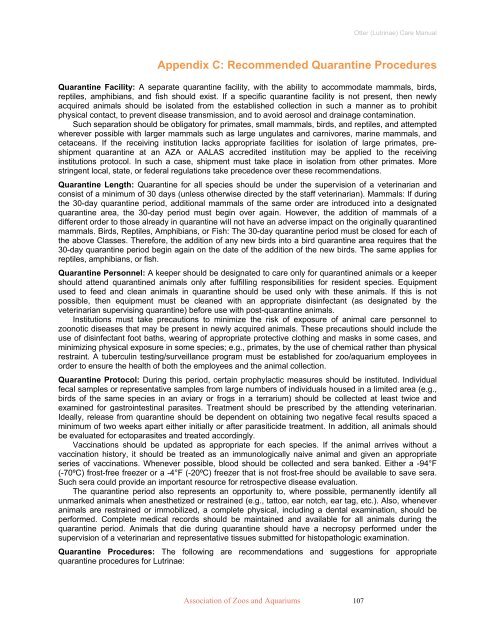Otter (Lutrinae) Care Manual - Association of Zoos and Aquariums
Otter (Lutrinae) Care Manual - Association of Zoos and Aquariums
Otter (Lutrinae) Care Manual - Association of Zoos and Aquariums
Create successful ePaper yourself
Turn your PDF publications into a flip-book with our unique Google optimized e-Paper software.
<strong>Association</strong> <strong>of</strong> <strong>Zoos</strong> <strong>and</strong> <strong>Aquariums</strong> 107<br />
<strong>Otter</strong> (<strong>Lutrinae</strong>) <strong>Care</strong> <strong>Manual</strong><br />
Appendix C: Recommended Quarantine Procedures<br />
Quarantine Facility: A separate quarantine facility, with the ability to accommodate mammals, birds,<br />
reptiles, amphibians, <strong>and</strong> fish should exist. If a specific quarantine facility is not present, then newly<br />
acquired animals should be isolated from the established collection in such a manner as to prohibit<br />
physical contact, to prevent disease transmission, <strong>and</strong> to avoid aerosol <strong>and</strong> drainage contamination.<br />
Such separation should be obligatory for primates, small mammals, birds, <strong>and</strong> reptiles, <strong>and</strong> attempted<br />
wherever possible with larger mammals such as large ungulates <strong>and</strong> carnivores, marine mammals, <strong>and</strong><br />
cetaceans. If the receiving institution lacks appropriate facilities for isolation <strong>of</strong> large primates, preshipment<br />
quarantine at an AZA or AALAS accredited institution may be applied to the receiving<br />
institutions protocol. In such a case, shipment must take place in isolation from other primates. More<br />
stringent local, state, or federal regulations take precedence over these recommendations.<br />
Quarantine Length: Quarantine for all species should be under the supervision <strong>of</strong> a veterinarian <strong>and</strong><br />
consist <strong>of</strong> a minimum <strong>of</strong> 30 days (unless otherwise directed by the staff veterinarian). Mammals: If during<br />
the 30-day quarantine period, additional mammals <strong>of</strong> the same order are introduced into a designated<br />
quarantine area, the 30-day period must begin over again. However, the addition <strong>of</strong> mammals <strong>of</strong> a<br />
different order to those already in quarantine will not have an adverse impact on the originally quarantined<br />
mammals. Birds, Reptiles, Amphibians, or Fish: The 30-day quarantine period must be closed for each <strong>of</strong><br />
the above Classes. Therefore, the addition <strong>of</strong> any new birds into a bird quarantine area requires that the<br />
30-day quarantine period begin again on the date <strong>of</strong> the addition <strong>of</strong> the new birds. The same applies for<br />
reptiles, amphibians, or fish.<br />
Quarantine Personnel: A keeper should be designated to care only for quarantined animals or a keeper<br />
should attend quarantined animals only after fulfilling responsibilities for resident species. Equipment<br />
used to feed <strong>and</strong> clean animals in quarantine should be used only with these animals. If this is not<br />
possible, then equipment must be cleaned with an appropriate disinfectant (as designated by the<br />
veterinarian supervising quarantine) before use with post-quarantine animals.<br />
Institutions must take precautions to minimize the risk <strong>of</strong> exposure <strong>of</strong> animal care personnel to<br />
zoonotic diseases that may be present in newly acquired animals. These precautions should include the<br />
use <strong>of</strong> disinfectant foot baths, wearing <strong>of</strong> appropriate protective clothing <strong>and</strong> masks in some cases, <strong>and</strong><br />
minimizing physical exposure in some species; e.g., primates, by the use <strong>of</strong> chemical rather than physical<br />
restraint. A tuberculin testing/surveillance program must be established for zoo/aquarium employees in<br />
order to ensure the health <strong>of</strong> both the employees <strong>and</strong> the animal collection.<br />
Quarantine Protocol: During this period, certain prophylactic measures should be instituted. Individual<br />
fecal samples or representative samples from large numbers <strong>of</strong> individuals housed in a limited area (e.g.,<br />
birds <strong>of</strong> the same species in an aviary or frogs in a terrarium) should be collected at least twice <strong>and</strong><br />
examined for gastrointestinal parasites. Treatment should be prescribed by the attending veterinarian.<br />
Ideally, release from quarantine should be dependent on obtaining two negative fecal results spaced a<br />
minimum <strong>of</strong> two weeks apart either initially or after parasiticide treatment. In addition, all animals should<br />
be evaluated for ectoparasites <strong>and</strong> treated accordingly.<br />
Vaccinations should be updated as appropriate for each species. If the animal arrives without a<br />
vaccination history, it should be treated as an immunologically naive animal <strong>and</strong> given an appropriate<br />
series <strong>of</strong> vaccinations. Whenever possible, blood should be collected <strong>and</strong> sera banked. Either a -94°F<br />
(-70ºC) frost-free freezer or a -4°F (-20ºC) freezer that is not frost-free should be available to save sera.<br />
Such sera could provide an important resource for retrospective disease evaluation.<br />
The quarantine period also represents an opportunity to, where possible, permanently identify all<br />
unmarked animals when anesthetized or restrained (e.g., tattoo, ear notch, ear tag, etc.). Also, whenever<br />
animals are restrained or immobilized, a complete physical, including a dental examination, should be<br />
performed. Complete medical records should be maintained <strong>and</strong> available for all animals during the<br />
quarantine period. Animals that die during quarantine should have a necropsy performed under the<br />
supervision <strong>of</strong> a veterinarian <strong>and</strong> representative tissues submitted for histopathologic examination.<br />
Quarantine Procedures: The following are recommendations <strong>and</strong> suggestions for appropriate<br />
quarantine procedures for <strong>Lutrinae</strong>:









